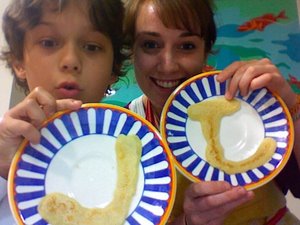 What happens in a math class? There were so many rules, but only one answer. You sit there and listen. Maybe the teacher asks you to come up and work out some problems on the board. But, honestly, if you find math boring, then you probably just copy the homework off your friend. Exams are an exercise in guesswork.
What happens in a math class? There were so many rules, but only one answer. You sit there and listen. Maybe the teacher asks you to come up and work out some problems on the board. But, honestly, if you find math boring, then you probably just copy the homework off your friend. Exams are an exercise in guesswork.
And, you know what? You were right, and your teacher was wrong – this stuff really isn’t useful after high school.
Of course math is absolutely necessary for certain professions, and some people really love it. I have engineer friends who use it all the time. But for your average high school screw-up, math isn’t nearly as useful as, say, a foreign language.
I teach university in Mexico. I see the looks on my students’ faces on the first day of class – the dull glaze to their eyes, the fear of losing so many hours of their young lives in stuffy classrooms at the mercy of some bore droning on and on.
This learning method – teacher speaks, students listen, students do exercises, repeat – has been beaten into them. It sure was beaten into me back in my university days when I was forced to study Spanish.
How ironic. Back then Spanish was one of my most boring classes, right up there with math. And now I live in Mexico and study Spanish as much as I can. What happened?
While in university I zoned out in class and barely learned a thing. Now, here in Mexico, studying Spanish is a means to an end. That end is communication.
My Spanish teachers taught Spanish like how my math teachers taught math. Learn the rules and formulas. Listen to some explanation and then do exercises from the book. Sure, to her credit, one of my Spanish teachers put us in pairs to get us to practice, but it just didn’t work. We all had a common language, English – too easy to fall back on.
My point is, why teach a language the way math (or history, or science) is taught? Languages have much more in common with music or sports, and they should be taught that way. Practice is vital. Mistakes are normal, even to be encouraged.
You don’t learn piano or hockey by opening up a book and answering questions. You learn by doing it. Your students should spend the majority of their time in class practicing, usually by speaking. Explain the grammar, give some examples, and then give them plenty of time to speak, with corrections of course.
Have you studied the P-P-P teaching method: presentation, practice, and production? It really does work. The presentation part, where the teacher explains the grammar topic, should be as brief as possible, maybe only five minutes in a one-hour class. The other two parts, practice and production, are when the students use the language. Maybe they make a survey, give a presentation, or have a conversation. Remember, it’s not only practice, but practice with correction. Strive to correct every mistake. Make notes if you have to.
That’s the benefit of learning in a classroom, which is why ESL teachers still have a job in this Internet age. Making mistakes is part of the learning process, which isn’t the same as, say, studying to be a doctor.



